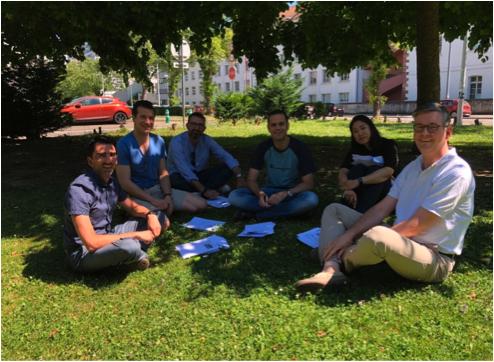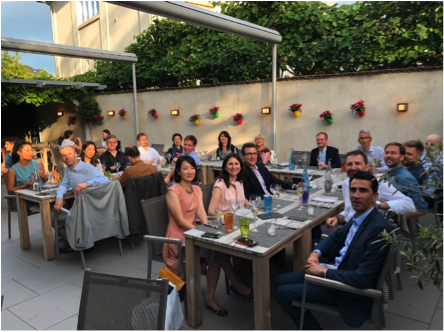MIPLM 2017-18, 6th module on business development with IP
Starting with the case studies from Hilti fleet management and Claas 365 FarmNet the MIPLM discussed the new role of IP within digital business models and how IP is integrated in business development in a era of digital transformation. This module was about the impact of business models on corporate structures and the role of business plans in creating new businesses. Business development has an organizational implication when companies want to integrate external innovation and in addition with the influencing parameters of markets for technology across industries, the students learned the success factors of IP management.
In addition, the limits of technology transfer and the limits to use IP within corporate financing schemes where discussed. Finally, the concepts of change management and successful procedures to promote change within corporate frameworks and organizations where presented and analyzed. The students learned and practiced describing and analyzing business models with the tool business canvas. Especially the integration of IP-based impacts in order to support the business in a business canvas was a challenge.
 The market for technology and IP was discussed on different examples like patent transactions acquisitions, licensing, brokers and auctions. The key influencing factors are sourcing good deals, valuation, motivation of buyers and sellers, transaction costs, lack of experience, exclusivity, geographic restrictions and payment conditions. Especially the comparison of US, Asia and European market places shows the different level of maturity, liquidity and efficiency.
The market for technology and IP was discussed on different examples like patent transactions acquisitions, licensing, brokers and auctions. The key influencing factors are sourcing good deals, valuation, motivation of buyers and sellers, transaction costs, lack of experience, exclusivity, geographic restrictions and payment conditions. Especially the comparison of US, Asia and European market places shows the different level of maturity, liquidity and efficiency.
The basic assumption about a market for IPRs is an increasing in innovation and economic value like gross domestic product and employment. IPR markets where discussed as a market for IPR assets and as a financial market.
 After the oral exams, which all participants passed the official closing dinner was held to celebrate the cooperative work which was made together over the last six months and modules.
After the oral exams, which all participants passed the official closing dinner was held to celebrate the cooperative work which was made together over the last six months and modules.
During the 6th module, the students worked on three different case studies: Claas, Rittal and Wilo and presented their solution with reference to the content of the whole program.
Case Study Rittal
Rittal Innovation Center – Switchgear and control manufacturing 4.0
Introduction: Smart Production
Industry Case Study: Rittal – Smart factory showcase for Industry 4.0
Case Study Tasks and Questions
The case study “Smart Production” summarizes the contents of the MIPLM course. Please apply the tools and concepts taught in the course to the present case study. If the text of the case study does not contain information on individual points, then please make suitable assumptions.
Task 1
The first module of the MIPLM dealt with the development of IP strategies. The focus was on topics such as the need for change processes for companies, the ability to change, the company’s market positioning by means of IP, IP portfolio analysis and the formulation of strategic targets for IP.
The changes in the industrial environment as a result of digital transformation necessitated an adaptation of Rittal’s IP strategy. Please describe the protection of digital business models in a nutshell, focusing on the typical layer model.
Please use the resource based view to show on which special resources Rittal can rely to succeed in the digital transformation.
Please also explain the concept of dynamic capabilities in this context and show how the F.L.G. is using its dynamic capabilities to handle the digital transformation.
Task 2
The second module was about decision theory, IP valuation and brand management.
Please use the decision process model to understand the decision-making situation in which Rittal was regarding its IP strategy. In particular, explain the decision that freedom to operate is a key objective of Rittal’s IP strategy development for the described innovation.
Task 3
Innovation management and process management were the content of the third module. The case study for the third module also provided insights into IP design.
Please rank the breadth and the radicalness of the innovation described in the case study.
In the case study to module 3, the approach to IP design was demonstrated by combining several design thinking methods. Describe this approach for digital business models. What is the main difference compared to application to physical innovations?
Task 4
The fourth module was about organization and institution economics.
In principle, a functional organizational structure or a divisional organizational structure can be selected for the implementation of “smart production”.
In the F.L.G. a divisional organizational structure is to be found. What advantages do you see for the development and implementation of the innovation? With which challenges does F.L.G. have to deal with this organizational structure?
Task 5
In the fifth module on the overall topic of leadership, IP Controlling was also discussed.
For IP controlling, the elements innovation, strategy, exploitation and portfolio control have to be coordinated. Which direction would you recommend in the development of the IP portfolio in view of the innovative digital business model?
Task 6
The sixth module of MIPLM dealt with the design of business models and change management.
Establishing and implementing a digital business model / value chain in control cabinet manufacturing requires a massive change process, not only at Rittal itself, but throughout the industry and also with stakeholders (such as external providers of planning services or assembly service providers) or customers. Please examine in a Force Field Analysis, reasons for and against such a change.
Here you can see the solution of this tasks from the students
Case Study Claas
Industry Case Study: Claas – Digital Revolution in Agriculture
Case Study Tasks and Questions
The case study “Smart Farming” summarizes the contents of the MIPLM course. Please apply the tools and concepts taught in the course to the present case study. If the text of the case study does not contain information on individual points, then they make suitable assumptions.
Task 1
The first module of the MIPLM dealt with the development of IP strategies. The focus was on topics such as the need for change processes for companies, the ability to change, the company’s market positioning by means of IP, IP portfolio analysis and the formulation of strategic targets for IP.
Please apply this content to this case study and explain in particular which factors made a change necessary from the point of view of CLAAS, which new market positioning should be realized and how CLAAS used portfolio analysis as a tool to examine the current situation.
Task 2
The second module was about decision theory, IP valuation and brand management.
CLAAS also had to make a decision about the future of the company. Explain, using decision theory, how this decision came about.
Task 3
Innovation management and process management were the content of the third module. The case study for the third module also provided insights into IP design.
Please briefly explain how defined IP needs can be met in a target aimed procedure.
Task 4
The fourth module was about organization and institution economics.
Please explain briefly which organizational forms were basically available for the implementation of the topic “Farm Management”. Which organizational form is to be preferred from your point of view?
Based on the Agency theory, please describe which problems for the IP work on the subject of “Farm Management” could be expected. What solution would you suggest for this problem?
Task 5
In the fifth module on the overall topic of leadership, IP Controlling was also discussed.
Please briefly describe the benefits of IP Controlling.
Then please take a brief look at the results of IP controlling at CLAAS.
Task 6
The sixth module of MIPLM dealt with the design of business models and change management.
Please point out which internal and external forces have forced CLAAS to implement the change.
Please also briefly explain at which points in the company you would expect the biggest changes in the implementation of the topic “Farm Management”.
Here you can see the solution of this tasks from the students
Case Study WILO
Energy efficiency and energy savings: a view from the building sector
Industry Case Study: WILO – High-Efficiency Pumps
Case Study Tasks and Questions
The case study “Smart Home” summarizes the contents of the MIPLM course. Please apply the tools and concepts taught in the course to the present case study. If the text of the case study does not contain information on individual points, then please make suitable assumptions.
Task 1
The first module of the MIPLM dealt with the development of IP strategies. The focus was on topics such as tools for strategy analysis, i.e. market-based view and resource-based view, types of generic IP strategies, IP strategy development, strategy formulation, etc.
Please explain briefly which external and internal factors made the change described in the case study necessary for Wilo.
Apply the market-based view and explain the overall goals Wilo should achieve by using IP.
What further measures (especially in the direction of the organization) does an analysis of the Wilo IP portfolio suggest?
Task 2
The second module was about decision theory, IP valuation and brand management.
One goal was to reposition the brand “Wilo” and strengthen the association with “pump intelligence”.
Please indicate how the brand identity of Wilo should be designed for this purpose.
Please identify the brand promise and explain how this brand promise can be exclusified.
Task 3
Innovation management and process management were the content of the third module. The case study for the third module also provided insights into IP design.
What process adjustments had to be made by Wilo in order to guarantee for the organizational implementation of the IP strategy?
Task 4
The fourth module was about organization and institution economics.
Please apply the institutional economics theory and explain what resistance Wilo had to overcome in order to implement a differentiation center.
Task 5
In the fifth module on the overall topic of leadership, IP Controlling was also discussed. Please explain the measures that are required to ensure that Wilo can permanently measure the success of its IP management and the impact of its IP portfolio (especially patents).
Task 6
The sixth module of MIPLM dealt with the design of business models and change management.
Please point out in brief words in which fields Wilo has identified a need for a change. Which basic requirement was considered for the success of the change process?
Here you can see the solution of this tasks from the students



